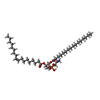+Search query
-Structure paper
| Title | Structure and catalytic mechanism of a human triacylglycerol-synthesis enzyme. |
|---|---|
| Journal, issue, pages | Nature, Vol. 581, Issue 7808, Page 323-328, Year 2020 |
| Publish date | May 13, 2020 |
 Authors Authors | Xuewu Sui / Kun Wang / Nina L Gluchowski / Shane D Elliott / Maofu Liao / Tobias C Walther / Robert V Farese /  |
| PubMed Abstract | Triacylglycerols store metabolic energy in organisms and have industrial uses as foods and fuels. Excessive accumulation of triacylglycerols in humans causes obesity and is associated with metabolic ...Triacylglycerols store metabolic energy in organisms and have industrial uses as foods and fuels. Excessive accumulation of triacylglycerols in humans causes obesity and is associated with metabolic diseases. Triacylglycerol synthesis is catalysed by acyl-CoA diacylglycerol acyltransferase (DGAT) enzymes, the structures and catalytic mechanisms of which remain unknown. Here we determined the structure of dimeric human DGAT1, a member of the membrane-bound O-acyltransferase (MBOAT) family, by cryo-electron microscopy at approximately 3.0 Å resolution. DGAT1 forms a homodimer through N-terminal segments and a hydrophobic interface, with putative active sites within the membrane region. A structure obtained with oleoyl-CoA substrate resolved at approximately 3.2 Å shows that the CoA moiety binds DGAT1 on the cytosolic side and the acyl group lies deep within a hydrophobic channel, positioning the acyl-CoA thioester bond near an invariant catalytic histidine residue. The reaction centre is located inside a large cavity, which opens laterally to the membrane bilayer, providing lipid access to the active site. A lipid-like density-possibly representing an acyl-acceptor molecule-is located within the reaction centre, orthogonal to acyl-CoA. Insights provided by the DGAT1 structures, together with mutagenesis and functional studies, provide the basis for a model of the catalysis of triacylglycerol synthesis by DGAT. |
 External links External links |  Nature / Nature /  PubMed:32433611 / PubMed:32433611 /  PubMed Central PubMed Central |
| Methods | EM (single particle) |
| Resolution | 2.8 - 3.2 Å |
| Structure data | EMDB-21461, PDB-6vyi: EMDB-21481, PDB-6vz1:  EMDB-21488: |
| Chemicals |  ChemComp-6OU:  ChemComp-3VV: |
| Source |
|
 Keywords Keywords | TRANSFERASE / Triglyceride Biosynthesis / Lipid Storage / Lipid Metabolism |
 Movie
Movie Controller
Controller Structure viewers
Structure viewers About Yorodumi Papers
About Yorodumi Papers







 homo sapiens (human)
homo sapiens (human)